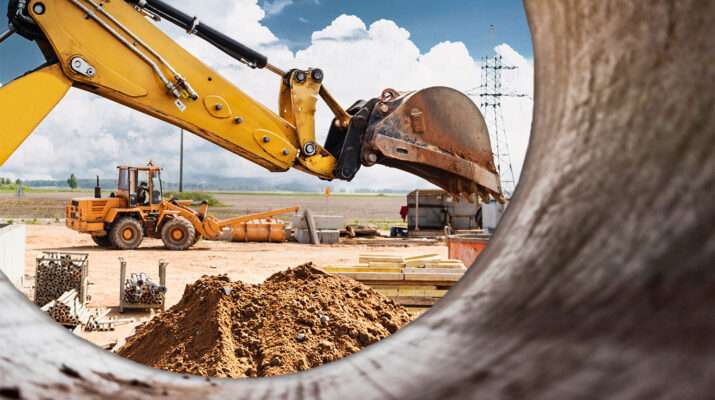The construction industry is heavily dependent on many factors during preparation and post-construction. Excavator attachments are one of these fundamental factors for all kinds of:
- Digging
- Grading
- Crushing
- And Demolition.
These attachment advancements are part of a new wave of industry developments and equipment innovation, making unique and dynamic improving factors to address the different needs and challenges that the construction industry faces.
What we will cover in detail is an in-depth look at various new technologies and industry developments that are literally changing the landscape of construction and how these innovations are shaping how excavator attachment technologies will evolve.
We’ll take a close look at how previous obstacles are being overcome by the new innovation and the ripple effect of them, so let’s get into it.
Telematics
Telematics is another showcase of equipment innovation. It transfers and receives information at longer distances, such as through satellite, cellular, or radio networks.
Telematics can help in the remote monitoring and control of excavator attachments and the collection and analysis of the data on their performance, state, and use.
For instance, through telematics, it is possible to make such adjustments from a distance, where the parameters, such as speed, pressure, and flow of hydraulic tools, are adjusted.
Telematics can also give instant feedback and warnings about attachment status and health, such as temperature, vibration, or wear of components. In addition, telematics facilitates the optimisation of use and maintenance of attachments by monitoring their location, condition, availability, and service records.
Telematics can offer several benefits for the construction industry, such as:
- Optimising the performance of excavator attachments, letting the operators adjust them to the specifics of the work and site conditions.
- Creating opportunities for preventive and predictive maintenance, as well as remote diagnostics and troubleshooting, of excavator attachments, which lower their downtimes and costs.
- The implementation of remote monitoring to assist in improving both safety and security to prevent any damage or even the possibility of theft.
- Improving sustainability and aligning with the local eco laws in place. By focusing on fuel and energy savings. Also, with a focus on emissions and noise reduction.
Artificial Intelligence
AI is a technology that deals with creating devices and systems capable of doing activities normally requiring human intelligence, like learning, reasoning, and decision-making.
AI can improve the performance and functions of excavator attachments and automate and simplify their operation.
For example, AI allows excavator attachments to automate material recognition and classification, such as:
- Soil
- Rock
- Concrete
- And Metal…
Then, they adjust their parameters, such as the force, speed, and angle of digging, cutting, or crushing.
AI can also empower excavator attachments to learn from their experience and data and continuously enhance their productivity and efficiency.
Additionally, AI aids operators in controlling and synchronising many excavator attachments simultaneously, as it offers guidance, recommendations, and comments and in some instances, full control of tasks and decisions.
AI can offer several benefits for the construction industry, such as:
- By allowing them to do more complex and various works such as sorting, grading, and recycling, the range and versatility of excavator attachments would be expanded.
- Enhancement of excavator attachments quality and accuracy by allowing them to adjust and optimise their performance according to the task and site specifications, as well as by detecting and acknowledging errors and anomalies.
- Enabling operators to delegate and supervise some of the tasks and decisions to the excavator attachments, as well as to receive assistance and support from the AI system, thus reducing the work and stress of the operators.
- Safety and reliability of the excavator attachment improved by preventing and lessening risks and hazards such as collisions, obstacles, or unstable terrain.
Electric and Hybrid Technologies
Electric and hybrid technologies are industry developments of technologies that utilise electricity, either as the only source of energy or combined with other energy sources, such as diesel, gas, or hydrogen, to run machines and systems.
Electric and hybrid technologies may be implemented to substitute or complement conventional hydraulic systems of excavator attachments and offer extra capabilities.
These are attachment advancements in the form of electric and hybrid technologies that can make excavator attachments more quiet, smooth, and accurate and allow them to produce and store electricity for later use or for powering other devices.
Electric and hybrid technologies also allow excavator attachments to operate in different modes and sources of energy suitable to the task and site conditions, such as the availability and the cost of electricity, fuel, or renewable energy.
Additionally, the electric and hybrid technologies can help the excavator attachments to have less emissions and noise and also to be more efficient and perform better.
Electric and hybrid technologies can offer several benefits for the construction industry, such as:
- Making the operators and workers more comfortable and convenient by letting them work in a more silent and cleaner environment in which they can also enjoy electricity for different purposes.
- Make the environmental weight of the excavator attachments less by consuming less fuel, having less emission, being considerably quieter, and being powered by renewable and alternative sources of energy.
- Cost reduction of both equipment operating and maintenance expenses, production levels, and performance is achieved.
- Making excavator attachments more versatile and adaptable by allowing them to work in various types of challenging sites, like urban, indoor, or remote areas, where power, fuel, and noise specifications may differ or be restricted.
Advanced Sensors
Advanced sensors are fascinating instruments that can deliver a plethora of important information to developers and site managers of many phenomena. We are talking about areas such as:
- Light
- Pressure
- Temperature
- Sound
- Motion
- And Distance
The sensor will then deliver them in the form of electrical signals. These are then stored for further analysis.
Advanced sensors can improve the operation and service life of attachments for excavators. By knowing what you are dealing with before metal hits earth, you’ll save not only time but a LOT of wear & tear on equipment, and the possibility of saving time if you hit the wrong soil.
An example is given that advanced sensors can make it possible for the excavator attachments to measure and control different parameters and conditions, such as the:
- Depth
- Width
- And Volume of Excavation
The weight and density of materials, the hardness and composition of surfaces, temperature and humidity of the environment.
This is made possible when advanced sensors also allow excavator attachments to communicate with other machines and systems, such as GPS, RFID, or IoT, and to exchange and synchronise data and commands.
In addition, with the help of advanced sensors, the safety and quality of earthmoving machinery attachments can be significantly improved by allowing them to detect and avoid obstacles, collisions, and damages, as well as to verify and validate the results and outcomes of the tasks.
Advanced sensors can offer several benefits for the construction industry, such as:
- Making the excavator attachments more efficient and accurate through attachment optimisation and automation, performance and operation monitoring, and error and waste reduction.
- Increase the visibility and transparency of excavator attachments by making them capable of providing more data and information to the operators and managers, as well as by facilitating remote monitoring and control.
- Bridging the integration and collaboration of excavator attachments to link and synchronise with other machines and systems for a smooth and smart workflow.
- Improving the ingenuity and creativity of excavator attachments, allowing them to explore and discover new opportunities and responses, not to mention, making them flexible to customisation and personalisation.
3D Printing
3D printing is a process of making three-dimensional objects by placing layers of material, which can be plastic, metal, or concrete, in line with a digital model or design.
3D printing enables the creation and modification of excavator attachments, as well as the addition of new features and adjustments.
For instance, 3D printing makes it possible to develop and produce excavator attachments according to the customers’ individual requirements, like the form, dimensions, weight, and functionality of the attachments.
3D printing can also facilitate the repair of excavator attachments on-site by printing spare parts and replacing the materials by melting and reshaping them.
In addition, 3D printing can allow excavator attachments to carry out completely new tasks by printing different types of material and shapes, for example, creating structures, sculptures, or artworks.
3D printing can offer several benefits for the construction industry, such as:3D printing can offer several benefits for the construction industry, such as:
- Sophisticating excavator attachments by making them flexible for customisation to meet the specific needs and desires of the customers and by increasing their durability and reliability.
- The cost and time of excavator attachments are reduced by allowing them to be produced and delivered more rapidly and less expensively, as well as maintained and replaced in a more convenient way.
- Improving excavator attachment sustainability and circularity by allowing them to be produced from biodegradable and environmentally friendly substances as well as to be.
Autonomous Operations
Autonomous operations are the technologies that allow machines and systems to perform tasks without human intervention or control by using self-driving, self-learning, or self-correcting capabilities.
The autonomous operations make it possible to utilise excavator attachments as stand-alone or cooperative entities, as well as to offer new capabilities and functions.
In this case, autonomous operations can allow excavator attachments to travel and operate in challenging and changeable locations, such as urban areas, underground areas, or underwater and to adapt and optimise their tasks and performance to the specific conditions at the site.
Autonomous operations can also cause excavator attachments to interact and collaborate with other machines and systems, like drones, robots, or vehicles and form intelligent and flexible networks and teams.
In addition, autonomous operations could contribute to the enhancement of safety and efficiency of the work that excavator attachments are able to do by allowing them to work without breaks and errors, as well as to deal with problems and obstacles.
Autonomous operations can offer several benefits for the construction industry, such as:
- Advancement of speed and performance of excavator attachments, allowing them to work faster and smarter, decreasing errors and waste.
- Enhancing the scalability and versatility of excavator attachments to operate in bigger and more diverse projects and sites and perform more complicated and diverse tasks.
- The safety and security of excavator attachments are improved by allowing them to operate in dangerous and hard-to-reach spots for the sake of their safety and the safety of others.
- Innovating the innovation and creativity of excavator attachments by the ability of the attachments to explore and find new possibilities and solutions, as well as by experimentation and testing.
SUMMARY
In recent history, we have all become aware of the vastly and rapidly changing landscape that technology has created and is bringing and changing our lives across all formats. Construction technology is certainly no stranger to this. Embracing these technologies and industry developments through equipment innovation and attachment advancements has carved a much better, cleaner and safer way for large-scale construction to take place without environmental issues and disruption to local communities.



